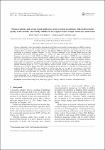Physical activity and screen-based media use: cross-sectional associations with health-related quality of life and the role of body satisfaction in a representative sample of German adolescents
Finne, Emily
Bucksch, Jens
Lampert, Thomas
Kolip, Petra
Purpose: Although it is widely accepted that physical activity (PA) positively, and screen-based media use (SBM) negatively, affects well-being, there is a lack of studies relating PA and SBM to health-related quality of life (HRQoL) in adolescents. We examined these associations in German adolescents for different HRQoL subdomains and explored the role of body satisfaction as a possible mediator. Methods: The 11–17-year-old subsample of the German Health Interview and Examination Survey (2003–2006) was analysed (N = 6813; 51.3% male). Cross-sectional associations of self-reported PA frequency and amount of daily SBM with HRQoL subscale scores (according to KINDL-R) were examined by hierarchical linear regression models, adjusting for the clustering of the sample and for a variety of possible confounders. The size and significance of indirect effects via body (dis)satisfaction (BDS) were examined by mediation analyses. Results: Higher PA frequency was significantly associated with higher HRQoL on nearly all subscales and dose–response-relationships were observable. Variations were greatest in terms of social well-being in boys (effect size d = 0.59) and physical well-being in girls (d = 0.43). Higher SBM was related to lower HRQoL on all subscales in girls and on some subscales in boys, with the largest effects for school functioning in both genders (d = 0.31 and 0.37, respectively). The mediated effects for PA and SBM were significant in both genders, but the sizes and the proportions of total effects mediated by body satisfaction were rather small. Conclusions: Higher PA frequency was associated with higher self-reported HRQoL, and higher SBM was associated with lower self-reported HRQoL in both genders, even after adjusting for relevant covariates. The results support the assumption of independent health impacts of both behaviours, although no causal relationship can be confirmed with these cross-sectional data. Mechanisms other than body satisfaction must largely account for the effects of PA and SBM on well-being.
No license information

